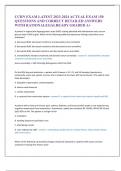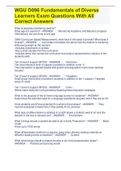CCRN EXAM LATEST 2023-2024 ACTUAL EXAM 150
QUESTIONS AND CORRECT DETAILED ANSWERS
WITH RATIONALES|ALREADY GRADED A+
A patient in hyperosolar hyperglycemic state (HHS) is being admitted with dehydration and a serum
glucose level of 836 mg/dL. Which of the following additional laboratory findings should the nurse
anticipate?
A. decreased BUN, decreased creatinine, and elevated serum osmolality
B. decreased BUN, decreased creatinine and decreased serum osmolality
C. decreased BUN, elevated creatinine and decreased serum osmolality
D. elevated BUN, elevated creatinine and elevated serum osmolality - answer-D. elevated BUN, elevated
creatinine and elevated serum osmolality
Serum osmolality > 320 mOsm/kg distinguishes HHS from DKA
On the fifth day post-admission, a patient with Q waves in V1, V2, and V3 develops hypotension,
tachycardia, and a pan-systolic murmur that is loudest at the lower left sternal border. This patient most
likely developed
A. idiopathic hypertrophic cardiomyopathy
B. inferior wall infarction
C. cardiac tamponade
D. a ruptured inter-ventricular septum - answer-D. a ruptured inter-ventricular septum (septal wall MI)
A patient with a history of chronic pain, asthma, diabetes, and heavy alcohol intake is now experiencing
cognitive impairment from medications. Assessment: awake but confused, BP 155/82, HR 84, RR 16 and
SpO2 95% on RA. This patient is at high risk for
A. Intubation
B. needing long-term psychiatric care
C. attempting suicide
D. over-sedation by staff - answer-C. attempting suicide (chronic medical illness, heavy alcohol intake,
and chronic pain)
Which of the following 12-lead ECG changes should be expected in a patient with acute coronary
syndrome involving the inferior wall?
,A. ST segment elevation and deeply inverted T waves in leads V4-V6, I and aVL
B. ST segment elevation in leads II, III, and all precordial leads
C. ST segment elevation and deeply inverted T waves in leads II, III, aVF
D. ST segment depression and T wave elevation in leads II, III, aVL - answer-C. ST segment elevation and
deeply inverted T waves in leads II, III, aVF
The major effect of acute lung injury (ALI) on the lung tissue is
A. decreased capillary permeability
B. increased function residual capacity (FRC)
C. decreased compliance
D. decreased alveolar surface tension - answer-C. decreased compliance (related to the alteration of
lung endothelium and vascular tissue. Results in stiffness and fluid filled non-aerated airways)
A patient with mitral regurgitation suddenly develops atrial fibrillation with a rate of 156. BP is 118/74.
The nurse should anticipate medication orders for
A. beta-blockers and vasopressors
B. warfarin (Coumadin) and alpha-agonists
C. beta-agonists and calcium-channel blockers
D. cardiac glycosides and calcium channel blockers - answer-D. cardiac glycosides (digoxin) and calcium
channel blockers
Which of the following pulmonary artery catheter findings would be anticipated in a patient with
chronic emphysema?
A. increased CVP
B. decreased CI
C. increased SV
D. decreased PAOP - answer-A. increased CVP (emphysema can cause cor pulmonale secondary to
increased pressure)
A patient is admitted complaining of chest pain and nausea. The ECG monitor reveals secondary AV
block, Type II. These findings are probably a result of occlusion of which of the following coronary
arteries?
,A. left anterior descending
B. left circumflex
C. posterior descending
D. right - answer-A. left anterior descending (LAD supplies blood to the septum)
A patient has heart failure secondary to ischemic cardiomyopathy and end-stage coronary artery
disease. Which of the following agents would be most beneficial
A. digoxin and diltiazem
B. carvedilol and lisinopril
C. veramapril and spironolactone
D. flecainide and hydralazine - answer-B. carvedilol and lisinopril (decreases after-load and minimizes
remodeling that is associated with HF)
When providing care to a patient with status epilepticus, the nurse should recognize that usually
A. it is a state of continuous seizures lasting more than two minutes
B. the patient comes out of the post ictal state between seizures
C. it results from abrupt discontinuation of anti-seizure meds
D. the cause of death is due to cerebral hemorrhage - answer-C. it results from abrupt discontinuation of
anti-seizure meds
A patient with a history of angina is admitted to the units after surgical repair of an AAA. The patient is
receiving a sodium nitroprusside (Nipride) gtt for severe postop hypertension. Twelve hours later, the
pattient complains of back pain.
BP 80/60
HR 120
UO 20 mL/hr
+1 left and right dorsalis pedis pulse
A. Admin of NS 200 ml/hr and prepare for doppler studies
B. spiral chest CT and emergent pericardiocentesis
C. procedural sedation and IABP insertion
, D. discontinuation of Nipride and prepare for surgery - answer-D. discontinuation of Nipride and prepare
for surgery (because the patient is hypotensive-DUH! w/ s/s of postop bleeding and hypovolemic shock)
A patient with head trauma is experiencing increased ICP. The ideal level at which to maintain arterial
pCO2
A. below 20
B. between 35 and 45
C. between 25 and 30
D. above 45 - answer-B. between 35 and 45 (normocapnia is essential for maintaining stable intracranial
pressure, because CO2 directly affects the degree of vasodilation in cerebral blood vessels)
Which of the following is an endpoint of volume resuscitation?
A. CVP 3 mm Hg
B. CI 2.4 L/min/m2
C. oxygen consumption 250 ml/min
D. BE 4 mmol/L - answer-C. oxygen consumption 250 ml/min (the amount of oxygen used by the body)
Which of the following life-threatening dysrhythmias is most frequently associated with HF?
A. bigeminy PACs
B. ventricular tachycardia
C. second-degree AV Block Type II (anterior wall MI)
D. junctional tachycardia (digoxin toxicity) - answer-B. ventricular tachycardia (Low Ef leads to stretch
and excitability of ventricles. Can lead to electrolyte shifts from diuretic therapy which can exacerbate
VTACH)
Which of the following hemodynamic profiles is most consistent with distributive shock?
A. BP 88/45, CI 1.5, CVP 15, PAOP 24, SVR 1200, svO2 47%
B. BP 85/40, CI 2.0, CVP 12, PAOP 20, SVR 1445, svO2 50%
C. BP 84/42, CI 2.5, CVP 3, PAOP 8, SVR 475, svO2 52%





